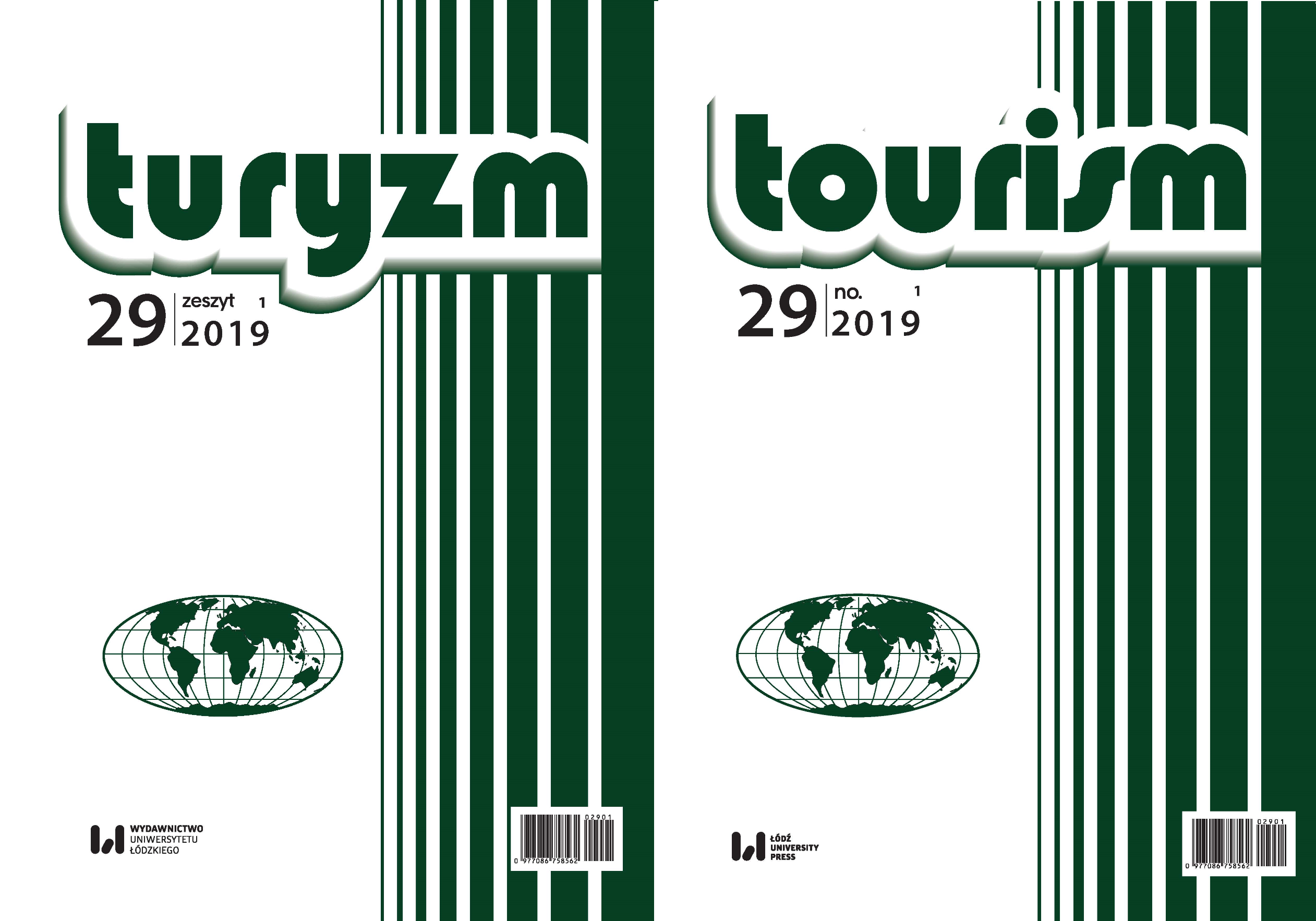Dance in tourism from an anthropological perspective: An introduction to the research issue
DOI:
https://doi.org/10.2478/tour-2019-0002Keywords:
dance in tourism, dance anthropology, cultural tourism, sports tourismAbstract
Nowadays, dance plays an important role in the modern tourism industry. Today, the craze for dancing creates great opportunities for cultural tourism. However, it should be remembered that there is a great danger of losing the most important meaning of dance by commercializing and reducing its essence. Dance tourism as discussed in the article is understood as travel for the purpose of learning about dance and its culture in places where given dance styles were born, or where they play an important national role as well as enjoying great popularity among the local community. This article is an introduction to the issue of dance tourism in an anthropological context. It presents potential attractions related to dance in the perspectives of cultural and sports tourism, it has an illustrative and descriptive character while its method is a literature review and presentation of popular examples.
Downloads
References
Banio, A. (2014). Taniec jako naturalna ekspresja ruchowa człowieka. In: J. Nowocień, K. Zuchora (eds). Wychowanie fizyczne i sport jako prawo człowieka i proces ciągłej edukacji (pp. 126-132). Warszawa: Akademia Wychowania Fizycznego Józefa Piłsudskiego, Polska Akademia Olimpijska, Fundacja „Centrum Edukacji Olimpijskiej”.
Google Scholar
Banio, A. (2015). Związek tańca z igrzyskami olimpijskimi. In: J. Eider (ed.), Wybrane zagadnienia olimpijskie w teorii i praktyce (pp. 73-79). Szczecin: Wydawnictwo Naukowe Uniwersytetu Szczecińskiego.
Google Scholar
Bliss, M. (2014). The soul of belly dance: Culture and history. Create-Space Independent Publishing Platform.
Google Scholar
Boas, F. (1972). The function of dance in human society. New York: Dance Horizons.
Google Scholar
Brocki, M. (2015). Antropologia język ciała. Wrocław: Astrum.
Google Scholar
Buczkowska, K. (2008). Turystyka kulturowa. Przewodnik metodyczny. Poznań: Wyd. AWF.
Google Scholar
Buczkowska, K. (2009). Kulturowa turystyka eventowa. In: K. Buczkowska, A. Mikos v. Rohrscheidt (eds), Współczesne formy turystyki kulturowej (pp. 91-118). Poznań: Wyd. AWF.
Google Scholar
Chasteen, J. (1996). The prehistory of samba: Carnival dancing in Rio de Janeiro. Journal of Latin American Studies, 28 (1), 29-47.
Google Scholar
Daniel, Y. (1996). Tourism dance performances authenticity and creativity. Annals of Tourism Research. 23, 4, 780-797.
Google Scholar
Dansmusset. Retrieved from: www.dansmuseet.se/en/ (10.01.2019).
Google Scholar
Davis, K. (2015). Dancing tango: Passionate encounters in a globalizing world. New York: New York University Press.
Google Scholar
Drożdż, T. (2012). Człowiek i taniec. Systemy choreograficzne jako profile badania kultury. Katowice. PhD thesis.
Google Scholar
Duncan, I. (1905). Taniec przyszłości: odczyt Izadory Duncan. Warszawa: Gebethner & Wolff.
Google Scholar
Dunham, K. (1969). Island possessed. Chicago: University of Chicago Press.
Google Scholar
Frankfort-Nachmias, C., Nachmias, D. (2001). Metody badawcze w naukach społecznych. Poznań: Zysk i S-ka.
Google Scholar
Gibson, H. (1998). Active sport tourism: Who participate? Leisure Studies, 17 (2), 155-179.
Google Scholar
Kaczmarek, S., Kaczmarek, J. (2015). Wielość rzeczywistości w przestrzeni turystycznej. Rozwój Regionalny i Polityka Regionalna, 31, 17-32.
Google Scholar
Kaeppler, A. (1967). The structure of tongan dance. University of Hawaii. PhD thesis.
Google Scholar
Kringelbach, H., Skinner, J. (2012). Dancing cultures. Globalization, tourism and identity in the anthropology of dance. [s. l.] Berghahn Books.
Google Scholar
Kurath, G.P. (1960). Panorama of dance ethnology. Current Anthropology, 1 (3), 233-254.
Google Scholar
Lifar, PP. (1969). The russian ballet in Russia and in the West. The Russian Review, 28 (4), 396-402.
Google Scholar
Malchrowicz, E. (2009). Półwysep Iberyjski – raj dla turystów kulturowych. Przegląd potencjału Hiszpanii i Portugalii dla rozwoju wybranych form turystyki kulturowej. Turystyka Kulturowa, 9, 4-26.
Google Scholar
Malchrowicz, E., Buczkowska, K. (2010). Fiesty hiszpańskie – jeszcze święta lokalne, czy już tylko atrakcje dla turystów? Turystyka Kulturowa, 4, 17-37.
Google Scholar
McCleary, K., Weaver, P., Meng, F. (2006). Dance as a tourist activity: Demographics, demand characteristics, motivation, and segmentation. Tourism Analysis, 10 (3), 277-290. DOI: 10.3727/108354205775322 970.
Google Scholar
McMains, J. (2015). Spinning mambo into salsa: Caribbean dance in global commerce. Oxford: Oxford University Press.
Google Scholar
National Museum of Dance. Retrieved from: http://www.dancemuseum.org/ (27.01.2019).
Google Scholar
National Museum of Dance. Retrieved from: www.dancemuseum.org (14.01.2019).
Google Scholar
Papadimitriou, L. (2000). Traveling on screen: Tourism and the Greek Film Musical. Journal of Modern Greek Studies, 18 (1), 95-104.
Google Scholar
Prylińska, A., Korczak, M., Nawrot, A., Strusio, M., Kaczmarek, J. (2018). Milonga – od produktu rekreacyjnego do turystyki kulturowej. Turystyka Kulturowa, 6, 94-111.
Google Scholar
Royce, A.P. (2002). The anthropology of dance. Alton: Dance Books.
Google Scholar
Ruxandra, A. (2018). A lo cubano: taniec i reprezentacje kubańskości w kontekście turystyki kulturowej. Lud, 102, 445-470.
Google Scholar
Sawala, K., Krawczyk, W., Bednarski, J. (2005). Wielkie fiesty Europy. Przewodnik etnoturystyczny. Poznań: Oficyna Wydawnicza „Atena”.
Google Scholar
Schwark, J. (2007). Sport tourism: Introduction and overview. European Journal for Sport and Society, 4 (2), 117–132. DOI: 10.1080/16138171.2007.116877799.
Google Scholar
Topić, M. (2016). Dance and cultural tourism in Croatia. International Journal of Religion and Society, 5 (1), 47-48.
Google Scholar
Using dance heritage for the tourism experience in airports. Retrieved from:www.worlddanceheritage.org (10.02.2019).
Google Scholar
Vianna, H. (1999). The mystery of samba. Popular music and national identity in Brazil. North Carolina: University of North Carolina Press.
Google Scholar
Wilson, M. (1972). The wedding cakes: A study of ritual change. In: J.S. La Fontaine (ed.), The interpretation of ritual (pp. 187-201). London: Tavistock.
Google Scholar
Downloads
Published
How to Cite
Issue
Section
License

This work is licensed under a Creative Commons Attribution-NonCommercial-NoDerivatives 4.0 International License.










